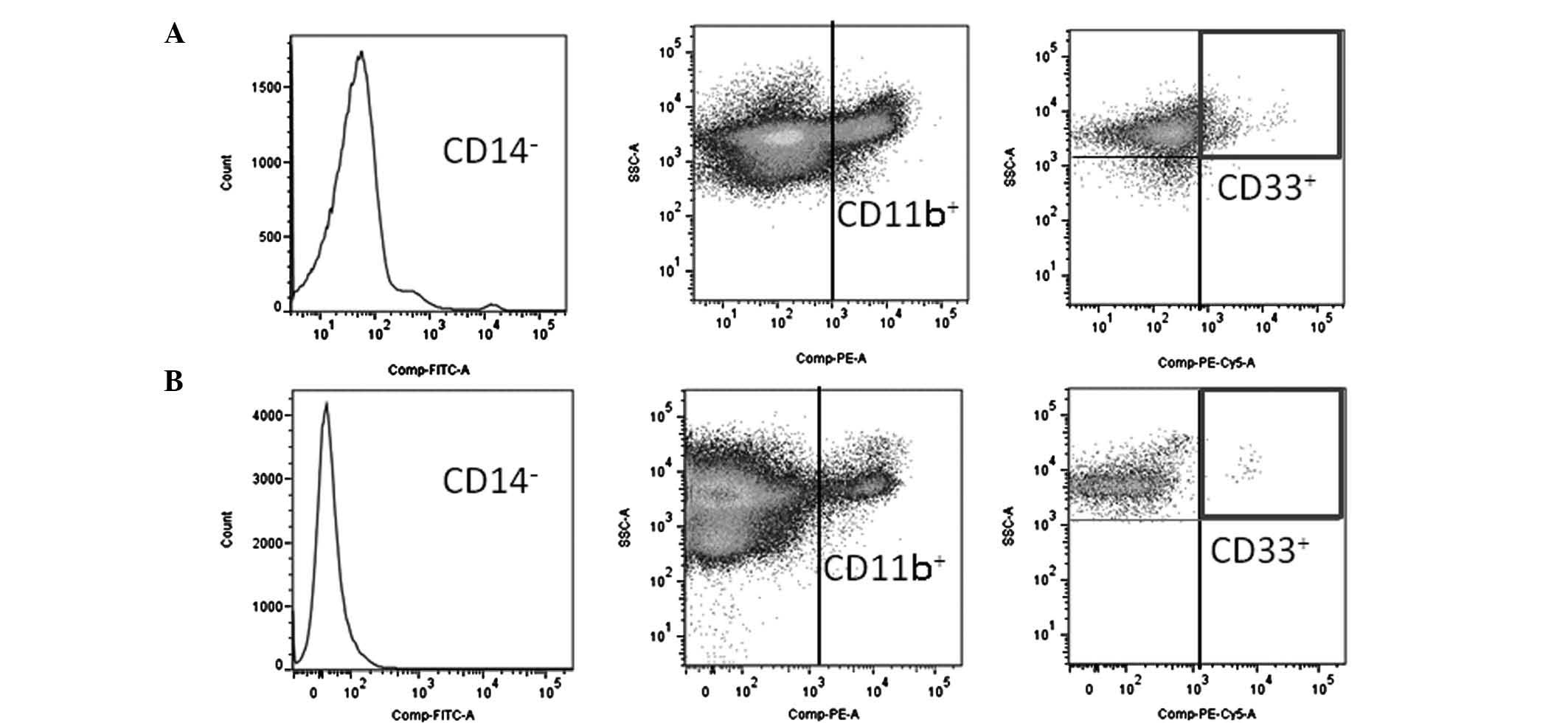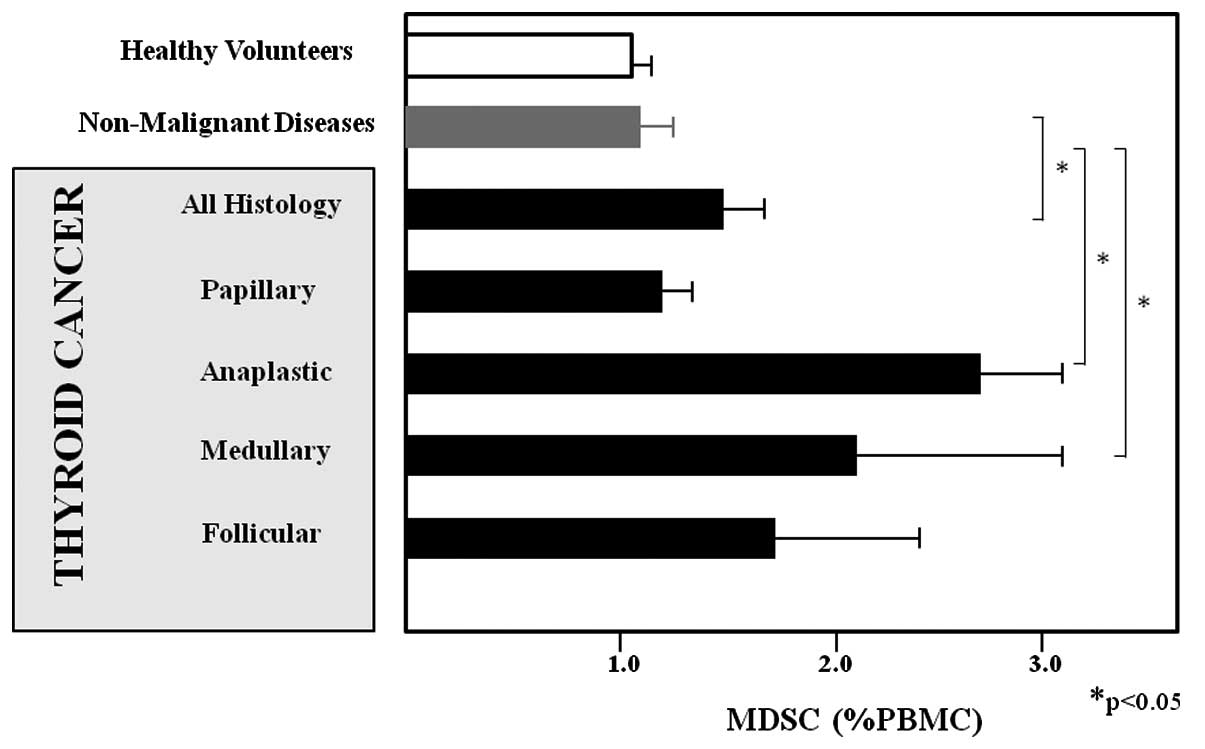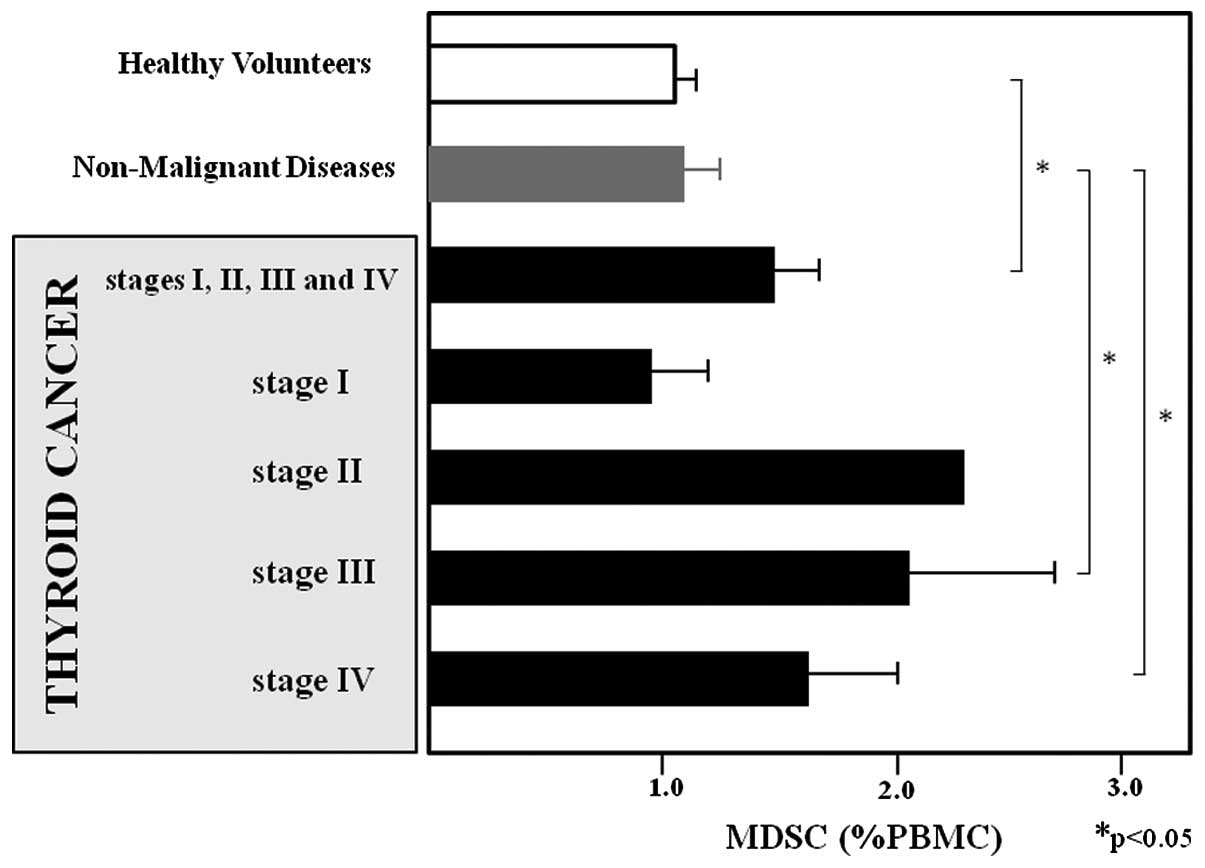Immunosuppression involving increased myeloid‑derived suppressor cell levels, systemic inflammation and hypoalbuminemia are present in patients with anaplastic thyroid cancer
- Authors:
- Published online on: August 22, 2013 https://doi.org/10.3892/mco.2013.170
- Pages: 959-964
Abstract
Introduction
Thyroid tumors represent 1% of all neoplasms and differentiated thyroid tumors (e.g., papillary and follicular types) account for 80–85% of all thyroid tumors (1–4). The majority of cases of differentiated thyroid tumors are associated with favorable outcomes. Anaplastic thyroid carcinoma (ATC) accounts for 5–15% of primary malignant thyroid tumors (5). The pronounced differences in the biological behavior of the various histological types of thyroid carcinoma are well known. In contrast to papillary and follicular thyroid carcinomas, ATC is one of the most aggressive neoplasms in humans. ATC is usually rapidly fatal, with a mean survival of 6 months after diagnosis (6,7). Since ATC is rare, there has not been a sufficient number of available cases to investigate, in order to obtain a better understanding of the natural history of this type of tumor and the factors that may affect the response to treatment and survival.
Numerous cancer immunotherapies that were developed in experimental animals have been investigated in clinical trials. Although some exhibited a moderate clinical efficacy, the majority were not effective (8,9). Recent studies identified cells of myeloid origin that are potent suppressors of tumor immunity and represent a significant impediment to cancer immunotherapy (8,9). Suppressive myeloid cells were previously described in patients with cancer (10,11), although their functional significance in the immune system has only recently been evaluated. Accumulating evidence (12–15) suggests that a population of cells with suppressive activity, referred to as myeloid-derived suppressor cells (MDSCs), may contribute to the negative regulation of immune responses during cancer and other diseases. We previously characterized circulating levels of MDSCs in patients with various types of malignant diseases, including patients with thyroid cancer (16).
Interleukin (IL)-10 is a potent immunosuppressive cytokine that is produced primarily by Th2 cells, macrophages and activated B cells. This cytokine has a wide range of biological activities and possesses immunosuppressive, anti-inflammatory and immunomodulatory properties that promote the regulation of a variety of immune cell differentiation and proliferation events (17). IL-10 is also an immunosuppressive effector cytokine produced by MDSCs (10,11).
Tumor development and growth occurs as a result of interactions between the tumor and host immune/inflammatory cells, with chronic inflammation being crucial in cancer development and progression. The laboratory markers of systemic inflammatory response and nutritional status, including C-reactive protein (CRP) and neutrophil/lymphocyte ratio, have been investigated as prognostic markers, with the evidence supporting their use being optimally demonstrated in surgical patients (18,19).
The aim of the present study was to characterize MDSC levels in normal volunteers and patients with thyroid cancer and to investigate the association between MDSC levels and immunosuppression, chronic inflammation and nutrition.
Materials and methods
Samples
Blood samples were collected from 49 patients with thyroid cancer, including 38 patients with papillary, 6 with anaplastic, 3 with medullary and 2 with follicular carcinoma. Samples were also collected from 18 patients with benign thyroid diseases [e.g., adenomatous goiter, follicular adenoma and hyperthyroidism (Basedow’s disease)] and from 22 healthy volunteers of similar age and gender distribution. Patients who received treatment (e.g., surgery, chemotherapy or palliative care) and were followed up at the Department of Organ Regulatory Surgery at Fukushima Medical University between January, 2011 and January, 2013 were enrolled in this study. The patients were aged 18–90 years and had histologically confirmed thyroid cancer. Of the 49 patients, 8 had stage I, 1 had stage II, 6 had stage III and 34 had stage IV disease. All patients were newly diagnosed and the blood samples were collected prior to the initiation of any treatment. Peripheral blood mononuclear cells (PBMCs) were separated on Ficoll-Hypaque (Pharmacia Biotech, Uppsala, Sweden). The isolated PBMCs were washed twice with RPMI-1640 medium (Wako Pure Chemical Industries, Ltd., Osaka, Japan) and were maintained frozen at −80°C in a freezing medium (BLC-1; Juji-Field Co., Ltd, Tokyo, Japan) until use.
This study was approved by the Ethics Committee of Fukushima Medical University (1095) and written informed consent was obtained from all the patients and healthy volunteers prior to enrollment.
Flow cytometry
The cells were labeled with fluorescein isothiocyanate (FITC), phycoerythrin (PE) and phycoerythrin-cyanin 5.1 (PC5). The antibodies used included those directed against FITC-conjugated CD14 (Abcam, Cambridge, UK), PE-conjugated CD11b (Beckman Coulter, Marseille, France) and PC5-conjugated CD33 (Beckman Coulter), diluted in phosphate-buffered saline (PBS) to 10 and 50 μg/ml. The cells were incubated with the antibodies for 20 min at 4°C and were then washed with PBS. Data acquisition and analysis were performed using a FACSAria II flow cytometer (BD Biosciences, Mountain View, CA, USA), accompanied by FlowJo software (TreeStar Inc., Ashland, OR, USA). The typical expression patterns are shown in Fig. 1.
Cytokine production by PBMCs
Approximately 106 PBMCs were incubated in 1 ml of RPMI-1640 medium containing 10% heat-inactivated fetal calf serum (Gibco BRL, St. Louis, MO, USA) and 100 μg/ml phytohemagglutinin (PHA; Sigma, Rockville, MD, USA) in 5% CO2 at 37°C for 24 h. The aliquots of these supernatants were then frozen and kept at −80°C until later use. The supernatant samples were subsequently thawed and used for measurement of the IL-10 concentration using enzyme-linked immunosorbent assay (ELISA) test kits (R&D Systems, Minneapolis, MN, USA). Each sample was only used once after thawing.
Lymphocyte proliferation assay
Lymphocyte proliferation assays were performed using PBMCs suspended in RPMI-1640 medium (Wako Pure Chemical Industries) containing 10% fetal calf serum (Sigma-Aldrich, St. Louis, MO, USA). Following the addition of 10 μg/ml PHA into the PBMC culture wells that were kept at 37°C in a 5% CO2 atmosphere, PHA mitogenesis was observed for 80 h. 3H-thymidine (Japan Radioisotope Association, Tokyo, Japan) was added to the wells for the last 8 h of incubation. The cells were harvested and 3H-thymidine incorporation was determined using a liquid scintillation counter (Perkin-Elmer Inc., Waltham, MA, USA) and expressed as counts per minute (cpm). The stimulation index (SI) was obtained by calculating total cpm/control cpm. PBMCs that had not been subjected to PHA addition were used as controls.
Markers of nutritional status and chronic inflammation
To evaluate the nutritional status of the subjects, the serum concentrations of albumin (determined by nephelometry) were assessed. CRP was used as an indicator of inflammation.
Statistical analysis
The differences between the groups were determined by Student’s t-tests. P<0.05 was considered to indicate a statistically significant difference. Inadequate amounts of blood were obtained from some patients; in these cases, certain measurements were not possible.
Results
PBMCs obtained from 49 patients with thyroid cancer, 18 with non-cancerous thyroid diseases and 22 healthy volunteers were investigated in this study. The concentrations of MDSCs were significantly higher in patients with any type of thyroid cancer (1.578±0.177, P<0.05), ATC (2.676±0.544, P<0.001), or medullary thyroid carcinoma (2.063±1.028, P<0.05) when compared to healthy volunteers (1.047±0.120 %PBMC). By contrast, there was no significant difference in the MDSC levels when comparing patients with papillary thyroid carcinoma (1.025±0.109), non-cancerous thyroid diseases (1.188±0.161 %PBMC) and healthy volunteers (Fig. 2). The levels of MDSCs according to the clinical stage of thyroid cancer are shown in Fig. 3. The MDSC levels of patients with stage I, II, III and IV thyroid cancer were 0.986±0.235, 2.36, 2.07±0.668 and 1.648±0.242 %PBMC, respectively, and those of patients with stage III–IV disease were significantly higher compared to those of healthy volunteers (P<0.05). Data regarding SI, CRP and albumin levels of patients with non-cancerous thyroid diseases and the histology of thyroid cancer are presented in Table I. The SI and CRP levels were significantly higher and the albumin levels were significantly lower in patients with ATC compared to those in patients with non-cancerous thyroid diseases (P<0.05). However, there was no significant difference in these parameters when comparing patients with non-cancerous thyroid diseases to patients with papillary, follicular and medullary thyroid carcinomas.
Table I.Stimulation index (SI) and serum concentrations of C-reactive protein (CRP) and albumin in patients with thyroid cancer according to histological type. |
Data regarding SI, CRP and albumin levels in patients with non-cancerous thyroid diseases according to the clinical stage of thyroid cancer are presented in Table II. The SI was significantly lower in patients with stage III–IV thyroid cancer compared to that in patients with non-cancerous thyroid diseases (P<0.05). Furthermore, the CRP and albumin levels were higher in patients with stage IV thyroid cancer compared to those in patients with non-cancerous thyroid diseases (P<0.05).
Table II.Stimulation index (SI) and serum concentrations of C-reactive protein (CRP) and albumin in patients with thyroid cancer according to tumor stage. |
Subsequently, patients with thyroid carcinoma were categorized into one of two groups according to a %PBMC of MDSC cut-off level of 1.578, which was the average %PBMC of MDSC in patients with any type of thyroid carcinoma. As shown in Table III, the size of the thyroid nodule tended to be larger (P<0.10) in patients with higher MDSC levels. Furthermore, in patients with higher MDSC levels, the production of CRP and IL-10 was significantly higher (P<0.05) and the levels of albumin were significantly lower (P<0.05) compared to those in patients with lower MDSC levels.
Discussion
The aim of this study was to characterize MDSC levels in patients with thyroid cancer, patients with benign thyroid diseases and healthy volunteers. Patients with ATC exhibited significantly elevated levels of circulating MDSCs, SI and CRP and significantly decreased levels of serum albumin compared to patients with non-cancerous thyroid diseases. Furthermore, MDSC levels were higher and SI was lower in patients with stage III and IV thyroid cancer compared to healthy volunteers. The CRP and albumin levels were lower in patients with stage IV thyroid cancer compared to those in patients with non-cancerous thyroid diseases. Additionally, the levels of CRP were significantly higher, the albumin concentration was lower and the production of IL-10 was elevated in patients with higher compared to those with lower MDSC levels. These data suggest that MDSC levels are increased in patients with ATC and advanced thyroid cancer. In addition, these patients exhibited impaired cell-mediated immune responses, chronic inflammation and nutritional impairment.
The ATC tissue produces large amounts of cytokines (e.g., IL-8 and IL-6) and growth factors (e.g., granulocyte colony-stimulating factor) (20–22). The exact mechanism underlying the increased production of immature myeloid cells in cancer patients has not been elucidated. However, the soluble factors produced by the ATC cells may affect the normal pathway of cell differentiation, resulting in the accumulation of MDSCs and increased clinical aggressiveness of ATC. The serum CRP level is a sensitive marker of inflammation and it is found to be increased in response to tissue damage or infection. The CRP level is also considered to be a prognostic factor in cancer patients (23,24). This acute phase reactant is produced primarily in the liver and its expression is upregulated by pro-inflammatory cytokines, such as IL-6 and IL-8 (25,26). The host immune system responds to tumor growth via elevated levels of inflammatory cytokines, which may further increase CRP levels. Hypoalbuminemia, typically observed in patients with cancer cachexia, is frequently associated with chronic inflammation. Furthermore, nutritional impairment associated with inflammation and immune suppression is observed in patients with ATC, which appears to be independent of the clinical aggressiveness of ATC.
The present study demonstrated that MDSC levels were higher in patients with systemic inflammation and hypoalbuminemia. In addition, immune suppression was closely associated with the Th2-dominant condition. Previous studies suggested that the MDSC levels may decrease following administration of chemotherapeutic or certain anti-inflammatory agents (15,27). Therefore, the regulation of MDSC levels using these strategies may facilitate anti-ATC treatment, including immunotherapy. However, further studies are required to verify this hypothesis.
Acknowledgements
The authors would like to thank Dr Takeshi Machida and Professor Hideharu Sekine (Department of Immunology, Fukushima Medical University) for their assistance in the flow cytometric experiments and Mrs. Hideko Taguchi for the management of research funding and facilities.
References
|
Franceschi S, Boyle P, Maisonneuve P, La Vecchia C, Burt AD, Kerr DJ and MacFarlane GJ: The epidemiology of thyroid carcinoma. Crit Rev Oncog. 4:25–52. 1993. | |
|
Reeve TS and Delbridge L: Thyroid cancers of follicular cell origin. Prog Surg. 19:78–88. 1988. | |
|
De Groot LJ, Kaplan EL, McCormick M and Straus FH: Natural history, treatment, and course of papillary thyroid carcinoma. J Clin Endocrinol Metab. 71:414–424. 1990.PubMed/NCBI | |
|
Samaan NA, Schultz PN, Hickey RC, Goepfert H, Haynie TP, Johnston DA and Ordonez NG: The results of various modalities of treatment of well differentiated thyroid carcinomas: a retrospective review of 1,599 patients. J Clin Endocrinol Metab. 75:714–720. 1992.PubMed/NCBI | |
|
Franssila KO: Prognosis of thyroid carcinoma. Cancer. 36:1138–1146. 1975. View Article : Google Scholar | |
|
Ain KB: Anaplastic thyroid carcinoma: behavior, biology, and therapeutic approaches. Thyroid. 8:715–726. 1998. View Article : Google Scholar : PubMed/NCBI | |
|
Giuffrida D and Gharib H: Anaplastic thyroid carcinoma: current diagnosis and treatment. Ann Oncol. 11:1083–1089. 2000. View Article : Google Scholar : PubMed/NCBI | |
|
Rosenberg SA, Yang JC and Restifo NP: Cancer immunotherapy: moving beyond current vaccines. Nat Med. 10:909–915. 2004. View Article : Google Scholar : PubMed/NCBI | |
|
Pardoll D and Allison J: Cancer immunotherapy: breaking the barriers to harvest the crop. Nat Med. 10:887–902. 2004. View Article : Google Scholar : PubMed/NCBI | |
|
Gabrilovich DI and Nagaj S: Myeloid-derived suppressor cells as regulators of the immune system. Nat Rev Immunol. 9:162–174. 2009. View Article : Google Scholar : PubMed/NCBI | |
|
Ostrand-Rosenberg S and Sinha P: Myeloid-derived suppressor cells: linking inflammation and cancer. J Immunol. 182:4499–4506. 2009. View Article : Google Scholar : PubMed/NCBI | |
|
Zea AH, Rodriguez PC, Atkins MB, Hernandez C, Signoretti S, Zabaleta J, McDermott D, Quiceno D, Youmans A, O’Neill A and Ochoa AC: Arginase-producing myeloid suppressor cells in renal cell carcinoma patients: a mechanism of tumor evasion. Cancer Res. 65:3044–3048. 2005.PubMed/NCBI | |
|
Ochoa AC, Zea AH, Hernandez C and Rodriguez PC: Arginase, prostaglandins, and myeloid-derived suppressor cells in renal cell carcinoma. Clin Cancer Res. 13:721s–726s. 2007. View Article : Google Scholar : PubMed/NCBI | |
|
Diaz-Montero CM, Salem ML, Nishimura MI, Garett-Mayre E, Cole DJ and Montero AJ: Increased circulating myeloid-derived suppressor cells correlate with clinical cancer stage, metastatic tumor burden, and doxorubicin-cyclophosphamide chemotherapy. Cancer Immunol Immunother. 58:49–59. 2009. View Article : Google Scholar | |
|
Gabitass RF, Annels NE, Crawshaw J, Pandha HS and Middleton GE: Use of gemcitabine-(GEM) and fluoropyrimidine-based chemotherapy to reduce myeloid-derived suppressor cells (MDSCs) in pancreatic (PC) and esophago-gastric cancer (EGC) (abs. 2588). In: Proceedings of the 2011 Annual meeting of Am Soc Clin Oncol; 3–7 June 2011; Chicago | |
|
Ohki S, Shibata M, Gonda K, Machida T, Shimura T, Nakamura I, Ohtake T, Koyama Y, Suzuki S, Ohto H and Takenoshita S: Circulating myeloid-derived suppressor cells are increased and correlate to immune suppression, inflammation and hypoalbuminemia in patients with cancer. Oncol Rep. 28:453–458. 2012.PubMed/NCBI | |
|
Moore KW, de Waal Malefyt R, Coffmann RL and O’Garra A: Interleukin-10 and the interleukin-10 receptor. Annu Rev Immunol. 19:683–765. 2001. View Article : Google Scholar : PubMed/NCBI | |
|
Blackwill F and Mantovani A: Cancer and inflammation: implications for pharmacology and therapeutics. Clin Pharmacol Ther. 87:401–406. 2010. View Article : Google Scholar | |
|
Coussens LM and Werb Z: Inflammation and cancer. Nature. 420:860–867. 2002. View Article : Google Scholar : PubMed/NCBI | |
|
Enomoto T, Sugawa H, Inoue T, Miyamoto M, Kosugi S, Takahashi T, Kitamura N, Yamamoto I, Konishi J, Mori T and Imura H: Establishment of a human undifferentiated human thyroid carcinoma cell line producing several growth factors and cytokines. Cancer. 65:1971–1979. 1990. View Article : Google Scholar | |
|
Iwasa K, Noguchi M, Mori K, Ohta N, Miyazaki I, Nonomura A, Mizukami Y, Nakamura S and Michigishi T: Anaplastic thyroid carcinoma producing the granulocyte colony stimulating factor (G-CSF): report of a case. Surg Today. 25:158–160. 1995. View Article : Google Scholar : PubMed/NCBI | |
|
Murabe H, Akamizu T, Kubota A and Kusaka S: Anaplastic thyroid carcinoma with prominent cardiac metastasis accompanied by a marked leukocytosis with a neutrophilia and high GM-CSF level in serum. Intern Med. 31:1107–1111. 1992. View Article : Google Scholar | |
|
Allin KH, Bojesen SE and Nordestgaard BG: Baseline C-reactive protein is associated with incident cancer and survival in patients with cancer. J Clin Oncol. 27:2217–2224. 2009. View Article : Google Scholar : PubMed/NCBI | |
|
Chen HH, Chen IH, Liao CT, Wei FC, Lee LY and Huang SF: Preoperative circulating C-reactive protein levels predict pathological aggressiveness in oral squamous cell carcinoma: a retrospective clinical study. Clin Otolaryngol. 36:147–153. 2011. View Article : Google Scholar : PubMed/NCBI | |
|
Il’yasova D, Colbert LH, Harris TB, Newman AB, Bauer DC, Satterifield S and Kritchevsky SB: Circulating levels of inflammatory markers and cancer risk in the health aging and body comparison cohort. Cancer Epidemiol Biomarkers Prev. 14:2413–2418. 2005.PubMed/NCBI | |
|
Erlinger TP, Platz EA, Rifai N and Helzlsouer KJ: C-reactive protein and the risk of incident colorectal cancer. JAMA. 291:585–590. 2004. View Article : Google Scholar : PubMed/NCBI | |
|
Kao J, Ko EC, Eisenstein S, et al: Targeting immune suppressing myeloid-derived suppressor cells in oncology. Cri Rev Oncol Hematol. 77:12–19. 2011. View Article : Google Scholar : PubMed/NCBI |












